|
Waste Statistics 2003 1 Waste generation and treatment1.1 Waste generation 2003 and developments 2002-2003 1.1 Waste generation 2003 and developments 2002-2003Waste generation in 2003 and developments in waste arisings from 2002 to 2003 are presented in Table 1. 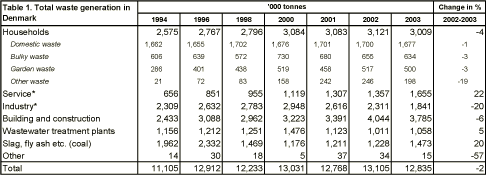
Source: ISAG; Danisco; the Association of Danish Recycling Industries and large scrap dealers; Elsam; Energi E2; and Reports to the Danish EPA on sludge from municipal wastewater treatment plants applied to farmland etc., and incineration of sludge at sludge incineration plants. (Sludge for recycling and incineration are represented by 2002 figures). Sludge are stated in wet weight, excluding however sludge for mineralisation which has been adjusted to 20 per cent dry matter. This applies to figures from 2001 and onward. Sludge for long-term storage has been included in sludge amounts applied to farmland etc. Sludge for recovery has been included in sludge amounts for incineration. The figures do not include imports of waste. Waste generation is stated as amounts of waste delivered to treatment plants from all primary sources. Primary sources include waste generators other than waste treatment plants (reprocessing plants, incineration plants, composting/biogas plants and landfills). Slag, fly ash and flue-gas cleaning products from waste incineration plants are therefore not included in the statement, as this would result in the waste being counted twice. Moreover, waste from the primary source recycling centres/transfer stations has been allocated among the other primary sources. The principles behind this allocation are explained in Annex 2. Other waste includes the fractions packaging waste, plastic, sludge, and electric and electronic equipment. *The figures pertaining to service and industry from 2001 and onwards should be interpreted with some reservation since there are fluctuations in the figures from the two sources which cannot be readily explained. In 2003, Danish waste generation amounted to 12,835,000 tonnes. This constitutes a 2 per cent fall relative to 2002. The fall primarily stems from a decline in industrial waste volumes of 20 per cent compared to 2002. However, as mentioned above there is great uncertainty linked to the development in industrial waste volumes. Furthermore, there has been a slight fall in the amount of waste from households and from building and construction. Waste from households amounted to 3,009,000 tonnes in 2003. This means a drop in waste generation of 4 per cent compared to 2002. All four waste types under household waste have gone down. Domestic waste arisings remain almost unchanged from previous years. As Table 1 shows, domestic waste arisings increased by 1 per cent during the period 1994 to 2002, showing only very slight changes from year to year [3]. Domestic waste includes separately collected paper, glass, organic waste, and other waste. The amount of bulky waste decreased by 3 per cent, or 21,000 tonnes, compared to 2002. The amount of waste reported as other waste fell by 19 per cent, which corresponds to 48,000 tonnes. From this report and onwards, the amount constituted by “other waste” includes packaging waste. Separated packaging waste became subject to reporting to the ISAG for the first time in 2001. However, this waste type is still not being reported to a sufficient extent. Therefore, packaging waste reported to the ISAG does not give a real picture of the total amount of collected packaging waste. Waste from the service sector amounted to 1,655,000 tonnes in 2003, which is 22 per cent more than in 2002. In absolute figures this is an increase of 298,000 tonnes. Waste from the service sector includes waste from institutions, trade and offices. The increase is apparent in the following fractions: waste suitable for incineration; waste not suitable for incineration; paper and cardboard; glass; hazardous waste; and other waste. These fractions have increased by 5 per cent, 7 per cent, 26 per cent, 47 per cent, 21 per cent, and 107 per cent respectively relative to 2002. The fractions: food waste/other organic waste; and healthcare risk waste show drops of 7 and 11 per cent respectively. Waste from industry [4] fell by 20 per cent. This involves a drop of 470,000 tonnes, from 2,311,000 tonnes in 2002 to 1,841,000 tonnes in 2003. The drop is primarily due to reductions in the following fractions: waste suitable for incineration; waste not suitable for incineration; paper and cardboard; plastic; ferrous metals; and sludge. These fractions have been reduced by 26 per cent, 27 per cent, 30 per cent, 5 per cent, 13 per cent, and 10 per cent respectively. By contrast, the fractions food waste/other organic waste; hazardous waste; and other waste have increased by 15 per cent, 44 per cent, and 16 per cent respectively. The amount of beet soil has neither gone up nor down. Since 2001 there has been a shift in waste arisings between service and industry, so that amounts of waste from the service sector have increased significantly while amounts of waste from industry have decreased to about the same extent. Amounts of waste from industry thus fell by 30 per cent in the period 2001 to 2003, whereas in the service sector volumes increased by 27 per cent. In the period 2002 to 2003 amounts of waste from industry fell by 20 per cent, whereas in the service sector volumes increased by 22 per cent. This shift between the two sectors may be due to faulty reporting, as the source manufacturing etc. was discontinued in 2001 as a result of the amendment of the Statutory Order on Waste [5]. This means that waste from industry must be reported as originating from one of the following 11 subgroups: food, beverages and tobacco; textiles, clothing and leather goods; wood-working and furniture; paper and graphical production; chemicals etc.; rubber and plastic; stone-working, pottery and glass; ferrous metals; other manufacturing; utilities; agriculture, forestry, fishery etc. It is likely that some carriers find it easier to report industrial waste as service-sector waste. Parties reporting to the ISAG are therefore encouraged to be aware of this possible source of incorrect reporting. Changes in the industrial structure, the fact that society is changing from an industrial to a knowledge society, may be another reason for the shift between the two sectors. The shift could be supported e.g. by the fact that the number of new companies in traditional industry went down during the 1990s, while the number of new companies in the knowledge services industry doubled. [6] The generation of waste in the building and construction sector decreased from 2002 to 2003. Volumes of building and demolition waste amounted to 3,785,000 tonnes in 2003, which is 259,000 tonnes, or 6 per cent, less than in 2002. The fall is primarily due to reductions in the fractions: not suitable for incineration; concrete; tiles; soil and stone; and other recyclable waste. These fractions were reduced by 24 per cent, 0.1 per cent, 13 per cent, 36 per cent, and 6 per cent respectively. Conversely, waste from the following fractions increased: other construction and demolition waste; asphalt; and other waste, which increased by 30 per cent, 28 per cent, and 19 per cent respectively. In 2003, 476,278 tonnes less soil and stone were reported. This is explained e.g. by the fact that the large operators in this area reported a significant decline in the market in the first half of 2003 leading to less waste from this fraction being received as opposed to in 2002. The second half of 2003 has been reported as normal. By far the major part, or 93 per cent, of waste generated by the building and construction sector is recycled. There has been a 5 per cent rise in the amount of sludge from municipal wastewater treatment plants: in 2003 the amount was 1,058,000 [7] tonnes, stated with a dry matter content of 20 per cent. This is 47,000 tonnes more than in 2002. From 2001, sludge for mineralisation has been included with a dry matter content of 20 per cent, so that this sludge is incorporated into the statistics with the same dry matter content as other sludge. In previous years, dry matter content for sludge for mineralisation was 1.5 per cent. Waste generation at coal-fired power plants increased by 20 per cent, which is an increase from 1,228,000 tonnes in 2002 to 1,473,000 tonnes in 2003. This is first and foremost due to the fact that energy generation was larger in 2003 than in 2002. The increase is due e.g. to the fact that in 2003 Denmark had net exports of electricity which constituted more than three times the total net exports in 2002. During the period 1996 to 2000, waste arisings from coal-fired power plants fell. This can be attributed e.g. to the fact that there has been a conversion of energy generation from coal to renewable energy resources. Denmark had net imports of electricity for the first time in this period in 2000 [8]. 1.2 Waste management in 2003In the following, developments in Danish management of total waste arisings are described. Waste management is compared to treatment targets in the Danish government's Waste Strategy 2005-2008. Table 2 shows that 8,439,000 tonnes, corresponding to 66 per cent of total waste arisings, were recycled in 2003. In absolute figures this is an increase of 57,000 tonnes, or 2 per cent, compared to 2002. 
Source: same as Table 1, and the Danish government's Waste Strategy 2005-2008. Waste led to incineration in 2003 amounted to 3,287,000 tonnes. This is actually a 57,000-tonne drop in waste amounts compared to the previous year, and it corresponds to 26 per cent of total waste arisings. Waste led to landfill in 2003 amounted to 981,000 tonnes, which is a decrease of 213,000 tonnes from 2002. The rate of waste landfilled amounts to 8 per cent of total waste arisings. The percentage share of waste led to landfill has fallen by 62 percentage points in the period 1994 to 2003, corresponding to a reduction in landfilled waste of 1,632,000 tonnes. As the table shows, the relative distribution in recent years among treatment options has varied only little. Variations are often explained by developments in waste arisings in individual fractions. For example, variations in amounts of residues from coal-fired power plants and construction and demolition waste have large implications on the total rate of recycling, as these two waste types account for a large percentage of total waste arisings and typically have a rate of recycling of 90 per cent or more. In the Danish government's Waste Strategy 2005-2008 the target of stabilising Danish waste generation is supplemented by a number of qualitative elements such as better exploitation of resources in waste, better quality in treatment of waste, and limitation of problems caused by environmental contaminants in waste. In general, targets for different sectors and individual fractions will mean an increased rate of recycling and incineration. Overall waste treatment targets for 2008 in the government's Waste Strategy 2005-2008 are 65 per cent recycling, 26 per cent incineration, and a maximum of 9 per cent landfilling. As can be seen from Figure 1, the overall targets for treatment of waste in 2008 were met in 2003. In 2003, one per cent of total waste arisings was reported under the treatment option storage. Storage means temporary landfilling of waste suitable for incineration until incineration capacity is available. The rate of recycling is one per cent above target, whereas incineration and landfilling meet the targets. The general fall in the rate of waste led to landfills can be attributed to the ban on landfilling of waste suitable for incineration that came into effect on 1 January 1997. However, there are other important factors. 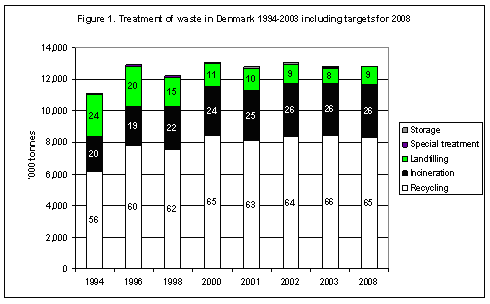
Source: same as Table 1. Note that total waste arisings in 2008 have been set to correspond to waste arisings in 2003. The figures for 2004 are not projections of developments in total waste arisings. Amounts of residues from coal-fired power plants have decreased significantly, and moreover they are being recycled to a larger extent than in previous years when they were mainly landfilled. 1.3 Treatment of waste without residues and construction and demolition wasteAmounts of residues from coal-fired power plants not only depend on energy consumption in Denmark, but also on exports of electricity to Sweden and Norway. In addition, due to the strategy of the past 10 years to phase out coal, a still larger shift is taking place from use of coal and coke to use of natural gas and renewable energy. Since 1996, when Denmark's electricity exports to Sweden and Norway were particularly large, amounts of residues have decreased steadily up until 2000. In fact, this is a 786,000-tonne decrease (see Table 29), corresponding to a 40 per cent reduction 40. In the period 2002 to 2003 there was an increase of 245,000 tonnes which is probably primarily a result of increasing exports of electricity e.g. to Sweden and Norway. [9] Naturally, this has an impact on developments of total waste arisings, but as residues have a very high rate of recycling, it also has an impact on the ability to meet overall treatment targets. A similar picture is seen for construction and demolition waste. As discussed in section 5.4, the rate of recycling of construction and demolition waste typically reaches around 90 per cent. Therefore, it is interesting to look at the distribution of waste between the different treatment options, if residues and construction and demolition waste are excluded from the statistics. Figure 2 shows the distribution between the different treatment options when residues from coal-fired power plants are excluded from the statistics. 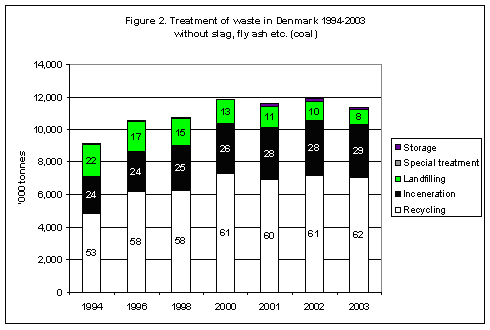
Source: Same as Table 1. When residues are excluded it is seen that 62 per cent of the remaining waste was recycled in 2003, which is a decrease of 107,000 tonnes from 2002. This should be seen in context with the fact that total waste arisings have fallen. The rate of remaining waste incinerated in 2003 is 29 per cent, which is to say that 7,000 tonnes less waste were incinerated in 2003 than in the year before. The rate of waste for landfilling is 8 per cent, which is a 109,000-tonne reduction compared to 2002. In absolute figures this means that in 2003, apart from residues, 11,597,000 tonnes of waste were generated, corresponding to a drop of 2 per cent from 2002. Of these, 7,085,000 tonnes were recycled, whereas 3,337,000 tonnes were incinerated, and 1,047,000 tonnes were landfilled. Moreover, 20,000 tonnes were given special treatment and 108,000 tonnes have been temporarily landfilled until incineration capacity becomes available [10]. Total waste amounts without waste from coal-fired power plants increased by 25 per cent from 1994 to 2003. Waste from the building and construction sector has also been excluded from statistics in Figure 3. This causes an increase in the rate of remaining waste for recycling, whereas the rates for incineration and landfilling decrease. In absolute figures, waste generation without residues and without waste from construction and demolition amounted to 7,814,000 tonnes in 2003, which is 20,000 tonnes, or 1 per cent, less than in 2002. In other words, if residues and waste from building and construction are excluded, there has been a fall in total waste arisings. Residues from coal-fired power plants and construction and demolition waste are recycled to a very large extent: in 2003, 97 per cent and 93 per cent respectively, cf. Chapter 5. It is seen that these two fractions play a very significant role in the compliance with overall waste treatment targets in the Danish government's Waste Strategy 2005-2008. 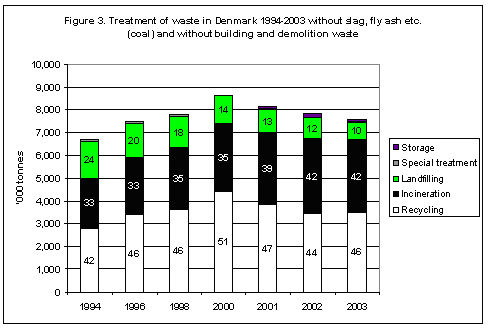
Source: Same as Table 1. 1.4 Treatment by source and waste typeFigure 4 shows total waste generation in 2003 analysed by source and treatment option. Figure 5 shows waste generation distributed by waste type and treatment option. Tables with detailed figures are given in Annex 1. Figure 4 shows that especially waste from the building and construction sector, coal-fired power plants and wastewater treatment plants is characterised by very high recycling rates. So targets for recycling in the Waste Strategy 2005-2008 have been met for waste generated by these three sectors. The rate of recycling of waste from industry is also relatively high: 63 per cent compared to a target of 65 per cent recycling. The high rate of recycling, however, is especially attributable to recycling of ferrous metals. Too much waste from this sector is still being led to landfill, namely 21 per cent against the target of only 15 per cent, and a challenge lies ahead to divert larger amounts of the other fractions from landfilling to incineration or recycling. The rate of recycling of waste from the service sector is likewise too low compared to the 2008 target of 50 per cent recycling. In 2003, only 44 per cent of the waste was recycled. This, however, constitutes a significant rise from 2002, when only 36 per cent was recycled. The target of 45 per cent incineration has been met. Waste in temporary storage for later incineration when capacity becomes available constitutes 2 per cent. Too much waste is landfilled: 8 per cent against the target of 5 per cent. The challenge for the service sector is to divert more waste from landfilling to recycling. Treatment of the waste type domestic waste also does not comply with the targets in the Waste Strategy 2005-2008, cf. Figure 5. Only 16 per cent of this waste was recycled in 2003. In the period 1994 to 2002 the recycling rate fluctuated between 14 per cent and 17 per cent. 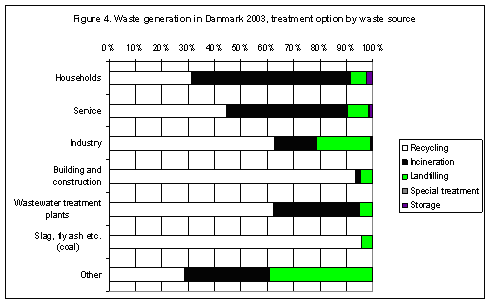
Source: Same as Table 1. The target is to reach a recycling rate for domestic waste of 20 per cent in 2008, whereas the targets for incineration and landfilling are 80 per cent and 0 per cent respectively. The rate of domestic waste incinerated in 2003 reached 83 per cent, whereas about 2 per cent was led to landfill [11]. 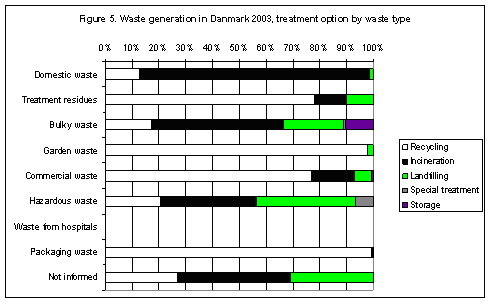
Source: Same as Table 1. 1.5 Developments in waste generation 1994-2003Table 3 shows total waste arisings in Denmark for the years 1994 to 2003. Breakdown of the information is by commercial sources. There was a 16 per cent increase in total waste arisings in the period 1994 to 2003. Waste generation was largest in 2002. The reduction in 2001 in waste arisings should be seen in context with the changes in methods applied. Waste arisings showed some fluctuations in the period 1994 to 2003, however they have been steady at around 13 mill. tonnes in recent years. The increase in the first half of the 1990s may be due partly to the fact that coverage of the ISAG system increased and partly due to real increases in waste arisings. The large amounts of waste in 1996 were primarily due to particularly high amounts of residues from coal-fired power plants in 1996, which in turn were due to large exports of electricity to Sweden and Norway. However, increasing waste arisings in 2000 must be attributed to an increase in waste from households and waste from building and construction. The same applies for 2002. 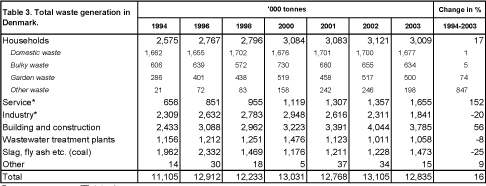
Source: Same as Table 1. Other includes e.g. packaging waste, plastic, sludge, and electric and electronic equipment. Footnotes [3] Developments from 1994 to 2003 are described in more detail in section 1.5 [4]In Waste Statistics 2002, the commercial sources with codes 20-30 (previously called manufacturing etc.) are called industry. [5] Statutory Order no. 619 of 27 June 2000 [6] Statistical Ten-Year Review 2003. Statistics Denmark. [7] The statement for 2003 from municipal wastewater treatment plants of the amount of sludge applied to farmland and incineration of sludge at sludge incineration plants is not yet available. For recycling and incineration, 2002 figures from the Danish EPA's sludge statistics have been used, whereas for landfilling ISAG figures for year 2003 have been used. See “Sewage sludge from municipal and private wastewater treatment plants in 2002”. Environmental Review No. 5, 2004, Danish EPA. [8] Preliminary figures from the Danish Energy Authority on energy generation and consumption, and CO2 emissions in 2003. [9] The Danish Energy Authority's, monthly electricity statistics. [10] Exemption clause in Section 37(3), Danish Statutory Order on Waste (Statutory Order No. 619 of 27 June 2000). [11] Note that organic domestic waste must be assigned to incineration. However, for islands that are not connected by land to an incineration plant there is an exemption from this duty of assignment.
|